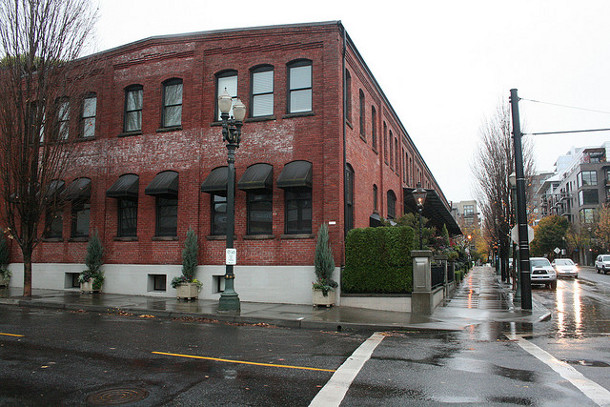Why Cities are Better for Watersheds than Suburbs
Development necessarily creates giant swaths of constructed areas that have no unifying ecosystem. It also disturbs existing natural areas that are part of the natural cycling of water, minerals, chemicals, plants and animals. Yet despite these complications, density is valuable in terms of impact mitigation on a per-person basis, as least as far as pollutant loading and watershed health is concerned.
We're used to thinking about pollutant loading on a per acre basis, so considering it on a per capita basis is a readjustment. It's quickly easy to see its value, though. Density, measured in dwelling units per acre (DUA), creates more impervious coverage per acre, and greater impervious coverage increases pollutant runoff — therefore pollutant loading per acre will be higher in very dense areas than in equivalent low-density developments. However, because there are more people in the same development footprint in a high density area, imperviousness is divided up among many, many people, lowering the overall pollutant loading per person. Per capita imperviousness decreases as density increases.
Impervious surface area is so important because it is the "best indicator for watershed health in general and for stream water quality in particular is the amount of impervious cover in a watershed… Polluted stormwater moving over impervious surfaces has no opportunity for infiltration into the soil, and thus remains polluted. Both runoff volume and pollutant concentration rise as imperviousness increases." Watersheds are very sensitive systems. Just 10 percent impervious cover – achieved by as few as one house every two acres — "markedly" impacts stream quality, and 25 percent impervious cover is enough to seriously degrade water quality and stream health.
All this suggests that density should be considered a best management practice (BMP). And Manhattan-type densities aren't necessary to achieve significant reductions in per capita pollutant loading. Even a twofold increase in density can reduce pollutant loading by 20% compared to low-density suburban developments. This is achievable with single-family or townhome style dwellings.
Dense development is one way to reduce per capita pollutant runoff on watersheds. How can landscape design solutions help further? By applying the same principles of open, undeveloped space, a partially exposed rain garden that extends underground or simple suspended pavement will work. These space-conscious solutions manage stormwater on-site, preventing the runoff that damages receiving waters with pollution, higher temperatures, and exaggerated peak flows. These solutions are also invisible once construction is complete, and are ideal for cities and other mostly-impervious areas like plazas, parking lots or parking lanes. As opposed to tanks or pipes that simply contain water, soils and trees actually process it – removing or containing contaminants and preventing re-entry into the groundwater and atmosphere.
Cities are heavily paved. This is part of their essential nature. Despite this plentitude of imperviousness, they are actually the better option in terms of reducing the impact on sensitive watersheds. High-density areas reduce pollutant loading on a per capita basis, acting as a truer indicator of damage to receiving waters than low-density areas. We remain far away from solutions that enable cities to function substantially more like undeveloped areas, but we do have some solutions to improve their ecological utility. Street trees, bioswales, and underground raingardens can play an important role in managing pollutant loading in urban areas.
For more information on this, read "Watersheds, Walkability and Stormwater: The Role of Density," By John S. Jacob.
Images: compujeramey and lumierefl


